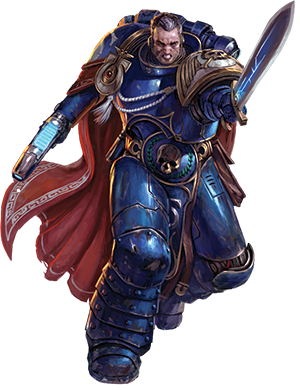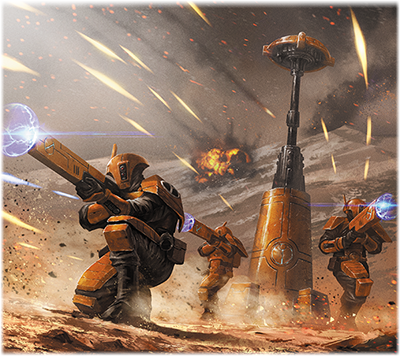Se les escapo la semana pasada, pero es hoy cuando oficialmente FFG anuncia un nuevo LCG ambientado en el universo 40k, Conquest The Card Game. No se, si tiene algo que ver, con el reciente finiquito de Warhammer Invasion y que los chicos de FFG, quieran continuar exprimiendo la franquicia de GW, que barata no debe ser.
En todo caso, un nuevo LCG, con ilustraciones espectaculares y un trasfondo con muchos seguidores. Veremos si tiene mejor suerte que Invasion.
Deep in the Ultima Segmentum, precious resources and lost artifacts have been found in the recently explored Traxis sector. In order to secure these treasures, the Imperium of Man wages a bloody conflict, desperately holding back tides of traitors, Daemons, and Xenos alike. The foul forces of Chaos plunder and corrupt, furthering their own goals of conquest and madness. Meanwhile, alien races of all kinds build their own empires, casting out all who would challenge their dominance. Blood will be spilt. Champions will rise. The only certainty is that there can be only one victor.
Fantasy Flight Games is proud to announce Warhammer 40,000: Conquest, a brand new Living Card Game® that casts two players into a head-to-head battle for the Traxis sector!

In every game, you take the part of a warlord, leading your armies into battle against your opponent in a bid to claim glorious victory. Even as you lead your bravest warriors into battle, you must plan for the future, establishing a presence on planets before the tides of war consume them in blood and fire. You must conquer the Traxis sector by strength of arms, for in the grim darkness of the far future, there is only war.

Aerial Reconaissance
At the beginning of a game of Warhammer 40,000: Conquest, the Traxis sector lies open before you, with planets awaiting the tramp of armies on the road to war. Each round begins with you and your opponent preparing for battle. Planet cards are arranged in a row between the players at the beginning of the game, and the planet farthest to the left of the starting player is the first planet. Each round, you or your opponent will clash at the first planet, and the victor will capture the first planet. Capturing planets is your ultimate goal in Warhammer 40,000: Conquest, as is explained further below.
You deploy units to establish your faction on planets across the sector and increase your warlord’s armies. Army units deploy to planets to establish your command of a world and do battle for your victory. Only the first planet in the row is eligible for capture each round, but you must carefully consider every planet. By deploying to other planets, you take the first step in securing them for future domination. After you and your opponent deploy, you bring your warlord’s might to bear against one planet by secretly selecting your choice on a servo-skull dial.

The above layout illustrates a game of Warhammer 40,000: Conquest in progress.
Once your warlord sets foot on a planet, the command struggle begins across the sector, representing a strategic battle for resources and influence at each planet. You and your opponent compare the number of command icons on their units at each planet. Whoever possesses the most command icons wins a command struggle at the planet, claiming additional card draw and resources as the spoils of war. These added cards and resources prepare you to play event cards during combat and swell the ranks of your army next round.
After the command struggles, combat begins at one or more planets. At the onset of a battle, the player with initiative exhausts one of his units to strike. Every unit has two numbers on the lower left border of its card. The top number is that unit’s attack power, while the bottom number is the unit’s hit points. The Soul Grinder, for example, has an attack power of four, and six hit points.

Whenever your unit strikes, you may choose which of your opponent’s units is the target of your unit’s attack. If you attack with the Soul Grinder, for example, you would potentially deal four damage to a chosen enemy unit at the planet. The course of battle is unpredictable, however, and your opponent can always react. A host of special abilities, keywords, and event cards allow both players to modify combat.
There is no mercy in Warhammer 40,000: Conquest! On each planet, units exhaust to strike until every unit there is exhausted. Then, every unit at the planet refreshes, continuing the battle until one side retreats or is utterly destroyed. Once all battles are resolved, you and your opponent receive resources and draw two cards before a new round begins. Visit the description page or look for our upcoming series of previews to explore every aspect of Warhammer 40,000: Conquest in intimate detail.

War Is Timing
To achieve victory in Warhammer 40,000: Conquest, you must demonstrate your superiority and your dominion over the sector. Some planets possess essential materials necessary for the armies of the 41st millennium. Others offer strategic advantages to those who hold them, while yet others are home to great technological wealth. Each of the planet cards possesses one or more symbols in the upper left hand corner, designating that planet’s assets. A planet like Elouith, for example, possesses only the Tech symbol, whereas Iridial has all three symbols: Material, Strongpoint, and Tech. These symbols grant no abilities by themselves, but the first player to collect three planets sharing a common symbol dominates the sector and wins the game.

Just because you can’t claim a planet immediately doesn’t mean you should ignore it completely. The bonuses granted to the player who wins the command struggle on a planet provide a vital infusion of resources or additional card draw. The world of Osus IV, for instance, grants two resources to the player winning the command struggle, whereas the strategically important forge world of Iridial only allows you to draw a card.
Winning the command struggle on planets across the sector is critical to victory. Not only do you have the opportunity to build up attack forces for future battles, these planets are your principal means of gaining more resources and drawing more cards than your opponent. But you cannot neglect the first planet and the battle there. Dividing your attention between the present and future is crucial to every game of Warhammer 40,000: Conquest.


Traitors, Xenos, and Heretics
Possible decks in Warhammer 40,000: Conquest are divided between seven distinct factions, each with its own unique flavor of play. You can lead the warriors of the Adeptus Astartes in glorious combat or command the combined forces of the Imperial Guard. Take on the role of an Ork boss and drive your Waaagh! to unlimited savagery, or devote yourself to the dark powers of Chaos. Tailor your fate as the Eldar, expand your empire as the Tau, or strike from the shadows with the Dark Eldar. No matter whom you choose, your goal remains the same: conquer the Traxis sector in the name of your people!
Deckbuilding is built around your warlord – the heart and soul of your army. Your warlord grants powerful special abilities, determines your starting resources and hand size, and serves as a vital part of your army. For example, Captain Cato Sicarius shows his strategic genius by allowing you to gain a resource whenever an enemy unit is destroyed at the same planet. Sicarius also shows two small numbers at the bottom of his card, indicating that you begin the game with seven resources and seven cards.


Although warlords are powerful, they are not invincible. If a warlord takes damage equal to his hit points, he becomes bloodied, causing his power to decrease and removing his special ability. For a bloodied warlord, danger lurks in any confrontation. Defeating your opponent’s bloodied general is another way to claim the honor of victory. Your warlords are no cowards, however, and you can’t simply leave them behind at headquarters. A warlord must commit to a planet every round. Although the warlord has the option to retreat quickly, he must still face the risks of battle.

Building an Army
Each warlord in Warhammer 40,000: Conquest comes with eight special cards, known as his signature squad, that form the beginning of your deck. Each of these cards pairs naturally with the warlord’s special ability and play style, giving you a natural foundation to begin building a deck around. The signature squad forms a starting point, but from there, you customize your deck by using any of the cards from your faction and one of your allied factions.
Even in the constant warfare of the future, you need not fight alone. Alliances may form between factions brought together by mutual cause or benefit. In Warhammer 40,000: Conquest, each of the seven factions has its place in the alignment wheel. When creating a deck, you may choose one of the two factions adjacent to your warlord’s faction to serve as your ally. You may include cards from your chosen ally’s faction at will, although certain cards are designated as loyal. These cards represent particularly loyal units, special wargear, or unique tactics, and may not be included in another faction’s deck.

The alignment wheel demonstrates which factions can form an alliance in one deck.
The options for modifying a deck are limitless, and this system of deckbuilding also means that you’ll never know exactly what you’re facing in a game of Warhammer 40,000: Conquest. You might see that your opponent has a Chaos warlord, but you don’t know if he’s playing a pure Chaos deck, or if he’s included cards from the Ork or Dark Eldar factions.
Commence Full Assault
The 41st millennium is an age of warfare and darkness. The only glory lies in battle. Lead your warlord’s armies to victory in Warhammer 40,000: Conquest, Fantasy Flight Games's newest Living Card Game. For more information on the game, visit the description page, and check back for a series of detailed previews in coming months. Look forWarhammer 40,000: Conquest at retailers near you in the third quarter of 2014!

















0 comentarios :
Dí lo que piensas...